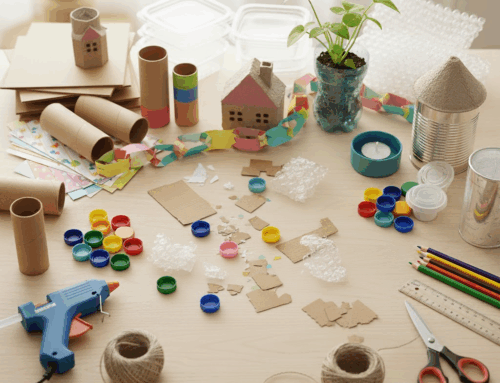Unsold thrift items, like clothes, furniture, and electronics, are often removed from stores within 30–90 days to make space for new donations. These items are managed through recycling, repurposing, or donations to avoid waste and support local communities. For example:
- Recycling: Textiles are turned into rags or insulation, and damaged shoes are used for playground surfaces.
- Repurposing: Furniture is refinished, electronics are salvaged for parts, and toys are cleaned or reimagined.
- Donations: Items are redistributed to shelters, schools, or overseas markets.
Organizations like City Thrift ensure unsold items are reused or recycled, reducing landfill waste while funding programs for homelessness and poverty relief. This approach benefits both the planet and people in need.
Problems with Unsold Inventory
The Scale of Waste in the U.S.
Each year, the U.S. produces an overwhelming amount of textile and household waste, much of which could be reused or donated instead of being dumped in landfills or incinerated. It’s not just textiles – household items of all kinds add to this growing problem. What’s especially troubling is that many of these discarded items are still in good condition and could make a difference for those in need if redirected properly. On top of that, this surplus waste places an enormous burden on landfills, creating long-term challenges.
Landfill Problems
When unsold items end up in landfills, they don’t just disappear. Textiles, for instance, decompose slowly and release methane – a powerful greenhouse gas – into the atmosphere. This process not only harms the environment but also squanders the resources that went into producing these items in the first place.
The frustrating part? A lot of this waste is entirely avoidable. Instead of tossing unsold yet usable items, they can be redirected through donation or recycling efforts. With the right systems in place, these environmental consequences can be significantly reduced. Non-profit thrift stores play a key role in making this happen.
How Non-Profit Thrift Stores Help
Organizations like City Thrift are stepping up to address this issue. By giving items a second life, these stores help keep usable goods out of landfills while also funding vital community programs. It’s a win-win: reducing waste and supporting local initiatives at the same time.
And just because something doesn’t sell right away doesn’t mean it’s destined for the trash. Through alternative distribution methods and community-driven projects, unsold items can still find a purpose. These efforts pave the way for creative recycling, repurposing, and donation opportunities, proving that waste doesn’t have to be inevitable.
Solutions: Recycling, Repurposing, and Donation Practices
Thrift stores give unsold items a second chance through recycling, creative repurposing, and donation programs.
Recycling Programs
To tackle the growing waste problem, unsold items are diverted from landfills and sent to recycling facilities where they’re broken down into raw materials. For instance, cotton is shredded into rags or yarn, wool is transformed into carpet padding, and synthetic fabrics are processed into polyester fill.
At recycling facilities, items are first sorted by fiber type and color before being broken down. Denim jeans are especially prized because of their durable cotton fibers, making them ideal for recycling.
Even heavily damaged items find a purpose. Worn-out shoes, for example, are sent to rubber recycling centers, where the material is ground up to create playground surfaces, athletic tracks, or new shoe soles. Metal components like eyelets are separated and sent to metal recycling facilities.
Repurposing Methods
Repurposing extends the life of furniture, household items, toys, and electronics. Old dressers are refinished, chairs are reupholstered, and scratched tables are given a fresh look with chalk paint or decorative finishes.
Household items are creatively reimagined – large glass jars become planters or storage containers, picture frames are spruced up with paint, and vintage suitcases turn into quirky storage solutions or pet beds.
Children’s toys also get a second life. Wooden toys are sanded and repainted, plastic toys are cleaned and repurposed into new playsets, and incomplete board games are salvaged for craft materials.
Electronics and appliances require a more specialized approach. Functional electronics might be bundled for sale at discounted prices, while non-working devices are disassembled to extract valuable metals like copper and aluminum.
When repurposing isn’t feasible, these items are redirected to donation programs.
Donation Pathways
Unsold thrift store items often benefit communities through donation partnerships. These stores collaborate with local shelters, schools, and community centers to ensure items are put to good use.
Regular donation pickups help maintain a steady flow of support to these organizations. This system not only reduces waste but also strengthens community ties by providing resources to those in need.
Community and Environmental Benefits
Managing unsold thrift items thoughtfully creates positive outcomes for both the environment and local communities.
Cutting Down on Waste and Promoting Reuse
Every item that gets recycled, repurposed, or donated plays a role in reducing waste and protecting the planet. When thrift stores adopt smart strategies for handling unsold goods, they keep materials in use rather than letting them pile up in landfills. This approach not only decreases waste but also limits the demand for new raw materials, easing the strain on natural resources and reducing the environmental toll of production.
Strengthening Local Communities
Finding new purposes for unsold items can make a real difference for people in need. Families and individuals facing tough financial times gain access to essential goods, thanks to redistribution efforts. Beyond that, volunteer programs focused on sorting and distributing these items bring people together, creating opportunities for neighbors to connect and lend a hand. City Thrift is a standout example of how these practices can benefit both communities and the environment.
City Thrift‘s Impact on Social and Environmental Causes
City Thrift shows how managing unsold items effectively can address both social and environmental challenges. Guided by the belief that nothing should go to waste while there are unmet community needs, City Thrift focuses on recycling, repurposing, and redistributing goods. This ensures donations have maximum impact, keeps items out of landfills, and provides much-needed resources to those in need. Their efforts also engage volunteers, fostering a sense of community while supporting local initiatives.
City Thrift’s Approach to Unsold Items
City Thrift has crafted a thoughtful system to extend the life of donated goods while reducing waste. Partnering with City Union Mission, they ensure every item has multiple chances to make a positive impact – whether through direct distribution, sales, or recycling.
Recycling and Repurposing at City Thrift
At the Vocational Training Center (VTC), donated items are carefully sorted by City Mission residents to decide their next step. Goods are sold across seven retail locations, online platforms, and warehouse events. If items remain unsold, they are recycled. As Jason Johnson, Director of Supportive Services at City Mission, puts it:
“If we’re unable to sell an item through any of those means, we recycle it. That’s the last way we can be good stewards of everything God gives us.”
Unsold items are baled and sent for bulk recycling, generating income to support City Mission’s services. Many of these recycled goods find renewed purposes overseas in places like Africa, India, and Pakistan. Meanwhile, unwearable clothing is transformed into rags for local businesses and the oil and gas industry. Even items like incomplete game boards and cardboard boxes are creatively reused or recycled for educational and practical purposes.
Donation and Redistribution Practices
Before resorting to recycling, City Thrift emphasizes direct distribution, ensuring donated items first reach City Mission residents and others in need. For items that cannot be directly distributed, a tiered approach – spanning retail stores, online sales, and warehouse events – supports programs aimed at tackling homelessness and poverty under City Union Mission.
Community Engagement and Impact
City Thrift’s approach also fosters meaningful community involvement. While sorting at the VTC is primarily done by City Mission residents, the organization encourages local volunteers to participate in various roles. This involvement not only reduces waste but also strengthens community bonds and promotes social initiatives. Johnson highlights this commitment:
“Every single thing we get in, we try to utilize or recycle.”
Creative projects, such as turning donated materials into custom dollhouses for children with special needs, showcase how unsold items can be reimagined into resources that benefit the community. Revenue from these efforts supports essential services like meals, shelter, and job training through City Union Mission, creating a cycle of support that directly benefits Kansas City residents.
The Impact of Smart Thrift Store Practices
When managed effectively, unsold thrift items can turn into resources that benefit both the environment and local communities.
Key Insights
The U.S. thrift industry faces a daunting challenge: managing unsold inventory. For example, Goodwill processes around 6 billion pounds of donations annually, but only 10–30% of these items sell. Meanwhile, 85% of U.S. textiles still end up in landfills. Addressing this issue requires thoughtful recycling, repurposing, and donation strategies.
Take Value Village as an example. They report that up to 95% of donations are either sold or repurposed, leaving only 5% as actual waste. This success stems from innovative recycling programs that turn unusable clothing into insulation or industrial materials, creative repurposing methods, and redistribution efforts that move inventory across stores or even overseas.
The environmental benefits of these practices are clear. Opting for secondhand clothing can reduce carbon emissions by about 25% compared to purchasing new items. Additionally, the U.S. exports 700,000 tons of used clothing annually, extending the life of these materials and keeping them out of landfills. These efforts contribute to a circular economy, reducing the need for new production and keeping materials in use longer. Beyond the environmental advantages, proper handling of unsold goods generates proceeds that fund programs like job training, homelessness relief, and poverty assistance. City Thrift stands out as a prime example of how these practices can turn potential waste into meaningful community support.
City Thrift: A Model for Responsible Practices
City Thrift ensures every donated item finds a purpose – whether through direct distribution, retail sales, or recycling. The proceeds from these efforts support vital programs, including shelter services, job training, and homelessness relief. By involving community members in evaluating and processing donations, City Thrift creates valuable work opportunities while strengthening its local impact.
This approach showcases how thrift stores can play a pivotal role in reducing waste and supporting vulnerable populations. With thoughtful management, unsold items transform from liabilities into resources, creating a ripple effect of benefits for both people and the planet.
FAQs
What happens to thrift store items that don’t sell?
Thrift stores take deliberate steps to manage unsold items in a way that reduces waste and benefits the community. Items that remain in good condition are often donated to local charities or held for future resale. As for damaged or unusable goods, many are recycled into materials like fibers or rags or even repurposed into entirely new products.
This approach not only cuts down on landfill waste but also aligns with broader efforts to promote sustainability. For instance, unsellable textiles might be sent to specialized recycling facilities or converted into other usable materials. By thoroughly evaluating the condition of each item, thrift stores ensure that waste is kept to a minimum while making a positive impact on the community.
What happens to thrift store items that don’t sell?
When thrift store items don’t sell, they often find a new purpose instead of heading straight to the landfill. Many of these items are recycled, repurposed, or donated to extend their usefulness. For instance, textiles might be transformed into industrial materials, while other goods could take on new life in creative or practical ways.
At City Thrift, unsold items are part of a bigger effort to create a sustainable cycle that benefits both the community and the planet. Through focused recycling and donation programs, City Thrift not only reduces waste but also supports initiatives like City Union Mission, which provides help to individuals experiencing homelessness and poverty. Every item donated or purchased contributes to this meaningful effort.
How can the community help manage unsold thrift items and support related programs?
Communities have the power to create meaningful change by donating gently used items, volunteering at thrift stores, or taking part in local programs that promote recycling and reuse. These actions do more than just cut down on waste – they also play a crucial role in supporting initiatives that assist those in need.
Organizations like City Thrift provide opportunities for people to make a difference. Whether it’s through donating items or offering time as a volunteer, these efforts support programs aimed at addressing homelessness and poverty, fostering stronger community ties, and encouraging environmentally friendly practices. Every contribution – big or small – helps improve both the environment and the lives of those in the community.






